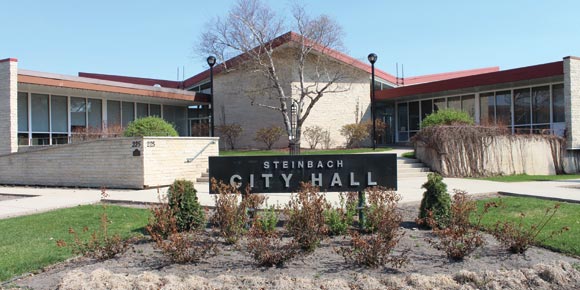by Christian Cassidy
Steinbach is located 50 kilometres southeast of Winnipeg in the Rural Municipality of Hanover. Founded in 1874, it became a town in 1946 and a city in 1997. With a population of 15,829 it is the third largest community in the province.
Steinbach Post Office (1953)
302 Main Street
The volume of mail handled at Steinbach’s post office increased dramatically after World War II when it became a regional mail distribution centre. In 1951, it was announced that a new post office building would be built on Main Street on what was part of an elementary school playground.
The new building was designed by Edwin A. Gardner who was chief architect for the federal government’s Department of Public Works from 1949 to 1963. He was responsible for the design of dozens, perhaps hundreds, of buildings from coast to coast; everything from large federal office buildings to post offices and border stations.
Gardner redefined the look of the federal government by adopting the international style of architecture. This modern look was characterised by sharp corners, rectangular lines, a flat roof, large windows and little in the way of exterior ornamentation. The Steinbach post office’s exterior of red brick with stone trim is typical of many of Gardner’s smaller buildings.
The Sigurdson Construction Company of Winnipeg won the bid to construct the two-storey, $142,000 building.
The main floor was dedicated to the post office, including a sorting area and lobby for over 1,000 postal boxes. The upstairs was reserved for the RCMP and included an office, two residential suites and even a jail cell, though due to a “planning error” that newspaper stories did not elaborate on it could not be used as a cell.
The post office building was officially opened on April 9, 1953 by provincial municipal affairs minister Edmond Prefontaine and Cornelius F. Barkman, who had served as Steinbach’s postmaster for 33 years.
Steinbach City Hall (1965)
225 Reimer Avenue
For much of Steinbach’s first decade as a town its municipal offices had to make do in rented accommodations. In 1954, the town purchased the former post office from the federal government and converted it for its own use but soon found it to be too small for its needs.
Steinbach’s population and importance as a regional centre grew throughout the early 1960s. This prompted town officials to consider constructing a custom-built town hall that would bring together the council chambers, administrative offices, courthouse and police station under one roof.
Architect Norman Earl Reimer was hired to come up with a design for the new building.
Reimer was a Steinbach native who graduated from the U of M’s architecture school in 1949 and practiced in Edmonton and London, England, before returning to Winnipeg in 1956. There are dozens of examples of his work stretching from Northwest Ontario to Saskatchewan.
The angular lines of Steinbach’s town hall are a trait of Reimer’s and can be seen in varying degrees on several his buildings, including the former Kinsmen Centre for the Handicapped in Winnipeg (1963) and the West Gate building of Bird’s Hill Provincial Park (1969).
Reimer said of his design, which resembles a compass from above, “The Council Chamber, representing the centre of local government, is the predominant feature. The flowing roof represents the compass of authority emanating from the central council chambers.”
Ratepayers voted in favour of constructing Reimer’s town hall on June 23, 1965. The total cost was $192,000, though the town would only have to borrow $128,000 of that.
A sod turning ceremony took place on September 21, 1965. Minutes later, C. T. Loewen and Son, the general contractor, began digging the building’s foundation. The reason for the rush was that the project had to be completed by March 31, 1966 to qualify for a 25 per cent rebate from a provincial infrastructure program.
The building was officially opened on September 27, 1966 when mayor Leonard A. Barkman cut the ribbon in front of a large crowd that included elected officials from all three levels of government and Lieutenant Governor Richard S. Bowles. Despite the later than expected opening date, Steinbach did receive its infrastructure program rebate.
In June 2017, a 3,500 square foot addition was made to Steinbach’s City Hall.
Steinbach Cenotaph (1956)
Main Street at Reimer Avenue
In 1954, the Steinbach Branch of the Royal Canadian Legion began planning for a local cenotaph dedicated to the men and women of the region who served in the two World Wars and Korea.
The federal government agreed to donate a corner of the post office lot at Main and Reimer as the location and Mr. Lowen of Lon’s Stoneworks was approached to provide a design and a quote.
The Legion spent the next year fundraising for the monument. Donations came from the town council, the R. M. of Hanover, the Hotelkeepers and Brewers Wartime Fund, (which was originally set up to purchase a Spitfire plane for the war effort), the Steinbach Women’s Institute and many others.
The Steinbach cenotaph was dedicated on Sunday, September 16, 1956. Presiding over the ceremony was Hon. Duff Roblin, who was not only premier of Manitoba but also the Vice President of the Regional Command of the Royal Canadian Legion. Sharing the stage were Peter Thiessen, president of the Steinbach Legion, and Mrs. D, J, MacIntosh, president of the Legion’s auxilliary.
The ceremony included a parade down Main Street made up of the colours of numerous Manitoba Legion branches, 30 members of the local Legion and the 50-person Warroad High School Band.
A newspaper article of the day called the parade, “a spectacle never before witnessed in Steinbach”
Christian writes about local history on his blog, West End Dumplings.



